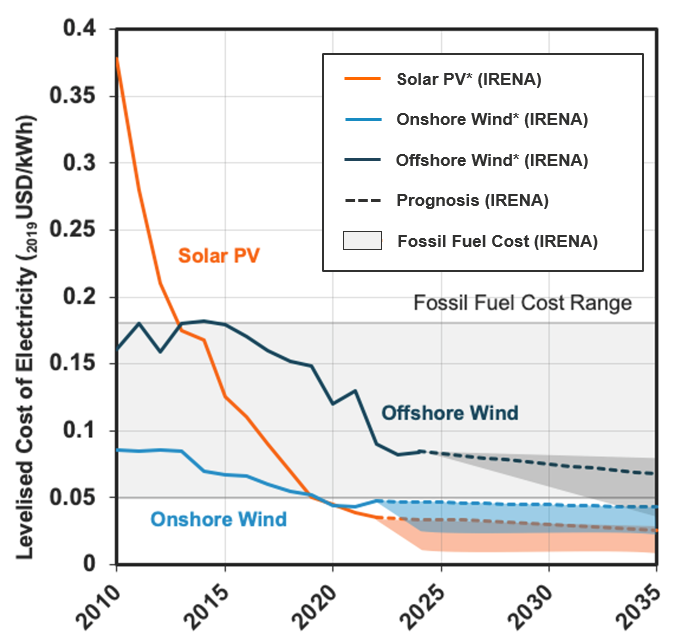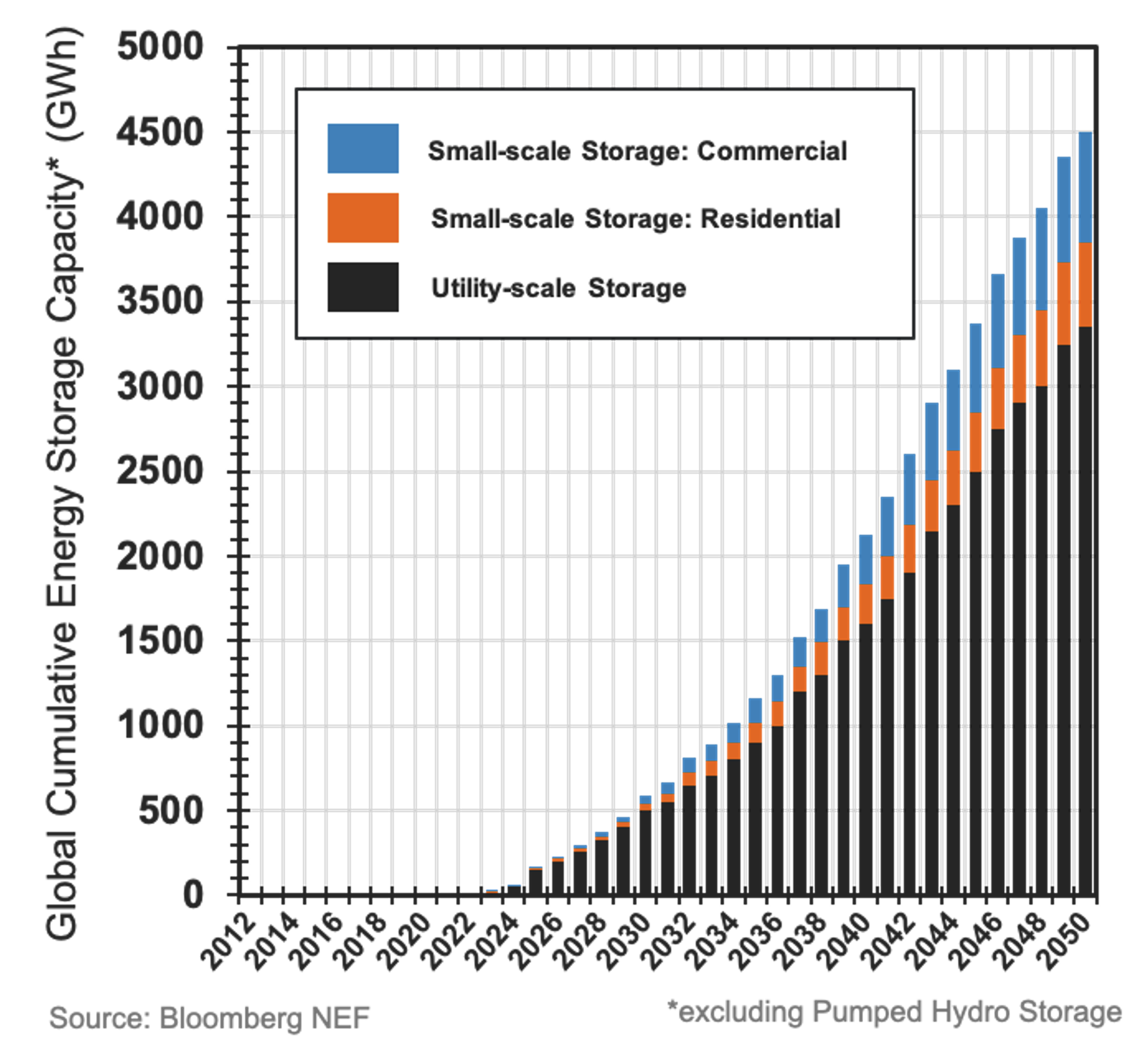Energy is the golden thread that connects economic growth, social equity, and environmental sustainability. With climate change at the forefront of global challenges, the transition to renewable energy sources is not just beneficial but imperative. This article dives into the pivotal role of energy storage in this transition, underscoring its significance in balancing the grid and ensuring a reliable supply of green energy.
The economic and environmental imperative for renewable energy
The mitigation of anthropogenic climate change is without a doubt one of the biggest challenges facing humanity. The effects of global warming are already perceptible, causing, for example the extreme weather events we have seen in the past few years. Beyond its obvious disastrous damage to our environment, climate change will also have a big financial impact on the world’s economy. All in all, global warming of 1.5 degrees centigrade is expected to cause cumulative damages of 72 trillion U.S. dollars by 2060 (Source: Energy Darwinism II: Why a Low Carbon Future Doesn’t Have to Cost the Earth, 2015.). These facts have led to growing environmental awareness and are putting pressure on political and economic leaders all over the world to take drastic measures to lower their countries’s emissions. A spotlight for these efforts is given to the energy sector, which contributes to a staggering one-third of all global emissions due to burning coal, oil, and gas. To make any serious effort toward decarbonization, fossil fuels must be replaced. Exactly this has led to the emergence of innovative, green technologies.
Global movement towards renewables

Figure 1: Levelized cost of electricity generation for renewable energy technologies as well as fossil fuels from 2010 to 2030
(Source: IRENA 2020, Fraunhofer ISE 2020)
This transition towards renewable energy is not merely a response to environmental concerns but also a strategic economic move. As illustrated in Figure 1, the levelized cost of electricity from renewables is rapidly decreasing, making it a financially viable alternative to traditional energy sources.
In line with the pressing need for decarbonization, renewable energies have been on the rise, with solar and wind power at the center of it. Supporting policies, as well as the fast maturing of the technologies, have led to very cheap and accessible wind and solar energy. Because of these sharp cost reductions over the past decade, solar PV is currently consistently cheaper than new coal- or gas-fired power plants in most countries (refer Figure 1). With this trend, renewables will meet 80% of the growth in global electricity demand by 2030 (Source: IEA (2020), World Energy Outlook 2020, IEA, Paris: https://www.iea.org/reports/world-energy-outlook-2020). Although hydropower remains the largest renewable source of electricity today, solar energy is leading the expansion in renewable energy capacity, consistently setting new records for solar infrastructure put into operation each year, followed by onshore and offshore wind. The rapid adoption of renewables, particularly solar and wind, which are intermittent by nature, requires substantial investment in grid infrastructure. This infrastructure must not only be robust to handle varying loads but also flexible enough to adapt to the unpredictable nature of renewable power generation. Such investment is termed an ‘additional premium’ because it is above the cost of traditional grid infrastructure that supports more predictable and controllable power sources like fossil fuels.
Rising Energy and electricity demand
Despite the goal to increase energy efficiency, e.g., in industry processes, and decouple GDP (Gross domestic product) from energy demand, electricity demand is expected to at least double by 2050 (Source: Bloomberg NEF). This rise in electricity demand is due to sector coupling, a term that refers to the electrification of end-use sectors like heating and transport as well as power and gas sectors (power-to-hydrogen and power-to-gas) with the aim of making these sectors based on renewables rather than fossil fuels. This increasing demand for renewables puts immense pressure on the power grid and its energy sources. However, the integration of renewable energy into the existing grid presents new challenges that need to be addressed to maintain reliability and efficiency.
Want to know more?
Get the latest publication and read more about how to master energy storage for your project.
Renewable adoption results in new challenges
Although renewables have low costs and great availability, they come with their own challenges. Renewable energy sources, namely solar PV and wind power, continuously outperform fossil-based generation due to low marginal costs. However, they face two major challenges when integrating into the power grid, which are not priced into the premium per kilowatt-hour (kWh): Firstly, they are naturally fluctuating due to varying sun and wind conditions and introduce uncontrollable intermittency in the power grid. Secondly, both solar and wind technologies have comparably low capacity factors of around 20 to 30 percent. In comparison, coal and nuclear power plants can reach up to 90 percent. This increases the necessary installed power to meet the same electricity output and amplifies the power fluctuation. In the past, changes in the electrical load were matched by controlling the power generation of conventional power plants. Currently, due to the intermittent and hardly controllable nature of renewable energy sources, this control mechanism is no longer a well-suited option. This trend is described as the “flexibility gap”. Commonly, four options are available to reintroduce the necessary flexibility into the system and maintain high security of supply:
- Generation: New flexibility on the supply side by disconnecting oversupply at any time.
- Transmission: Flexibility through the expansion of the power grid, balancing geographically separated oversupply and scarcity of generation.
- Consumption: Flexibility through demand response, a controlled change in the power consumption of an electric load to better match the demand for power with the supply.
- Electric Energy Storage: With “energy storage”, the produced energy is stored so it can be used later.
Energy storage as best scalable solution for grid flexibility
So let’s evaluate the above-mentioned solutions for their feasibility. Flexibility through installing even more renewable energy sources (1) and transmission lines (2) comes, despite being technologically feasible, with disproportionate social acceptance costs. These costs refer to the social and environmental impact of infrastructure projects, such as land use and community disruption, which can lead to public resistance and regulatory hurdles. This prevents it from becoming a widespread solution. Demand response (3) solutions on the other hand, such as controlling a large number of electrical devices to mitigate fluctuations, are on the rise. However, we see large reservations on the side of industries as well as residential customers, who do not like changing their behaviors to match wind and/or solar production. This prevents it from being an easily scalable solution, thus preserving an inelastic demand curve of electricity. Finally, the remaining option is electric energy storage (4). As it has the capability of providing energy flexibility services in an affordable and easily scalable manner, it is believed to play a crucial role in enabling the next phase of the energy transition worldwide (Source: IRENA, BloombergNEF, McKinsey & Company).
Expansion and limitations of utility-scale energy storage markets
Drawing on the same conclusion, policymakers, like the European Commission, utilities, and transmission operators worldwide have started to commission new projects for energy storage systems (Source: DOE Energy Storage Database). In 2017, the stationary energy storage market reached a milestone of approximately 1.6 gigawatts of installed capacity, representing a significant economic footprint with a market value of around 1.16 billion euros (Source: Bloomberg NEF).

Figure 2: Expected growth potential for energy storage divided into commercial, residential, and utility-scale applications. Source: Bloomberg NEF
The latest reports by Bloomberg NEF, IEA and Fraunhofer ISE confirm a rising market demand for energy storage systems in the coming 30 years. Bloomberg NEF maps a total utility-scale storage demand of 200 GWh by 2025, 500 GWh by 2030, 1600 GWh by 2040 and 3400 GWh by 2050 (refer Figure 2). This projection by Bloomberg NEF is considered a conservative estimate, likely based on current trends in energy policy, technology advancements, and market dynamics. It assumes a steady progression without factoring in potential breakthroughs in energy storage technology or drastic policy changes that could significantly increase the pace of storage deployment. And based on IRENA’s calculation, an estimate of 9000 GWh for stationary storage will be needed until 2050 to reach goals for extensive reduction of carbon emissions.
The demand for energy storage will be distributed evenly all over the world due to the common goal of mitigating carbon emissions and the favorable economics of renewable energy. This market pull for grid flexibility needs to be satisfied by a large amount of energy storage. This demands a sustainable, scalable, and resource-efficient technology to make the shift to 100% renewable energy a sustainable one. To better understand which technologies are best suited for this need, a closer examination of the current storage technology landscape and concomitant trends is needed.
Conclusion and key takeaways
The transition to renewable energy, driven by the urgent need to address climate change, is critically dependent on the advancement and integration of energy storage technologies. These technologies are pivotal in overcoming the inherent challenges of renewable sources and ensuring a stable, sustainable energy future.
Key Takeaways:
- Grid Integration: Master energy storage systems to enhance grid stability and integrate variable renewable sources like wind and solar effectively.
- Cost Efficiency: Leverage the declining costs of energy storage to improve the financial viability of renewable projects and proposals.
- Market Opportunities: Stay informed about expanding energy storage markets to identify new business opportunities and partnerships.
- Innovation Adoption: Embrace and contribute to technological advancements in energy storage to stay competitive and offer cutting-edge solutions.
- Policy Engagement: Engage with policy developments to advocate for supportive measures and understand regulatory changes that affect energy storage deployment.
- Sustainability Leadership: Champion the adoption of energy storage in your projects to lead by example in the transition to a more sustainable and resilient energy system.
By focusing on these areas, professionals in the renewable energy sector can effectively contribute to and benefit from the growth of energy storage, ensuring their work not only advances the industry but also contributes to a more sustainable future.
Discover more Energy Insights
Get the latest publication and read more about how to master energy storage for your project.

